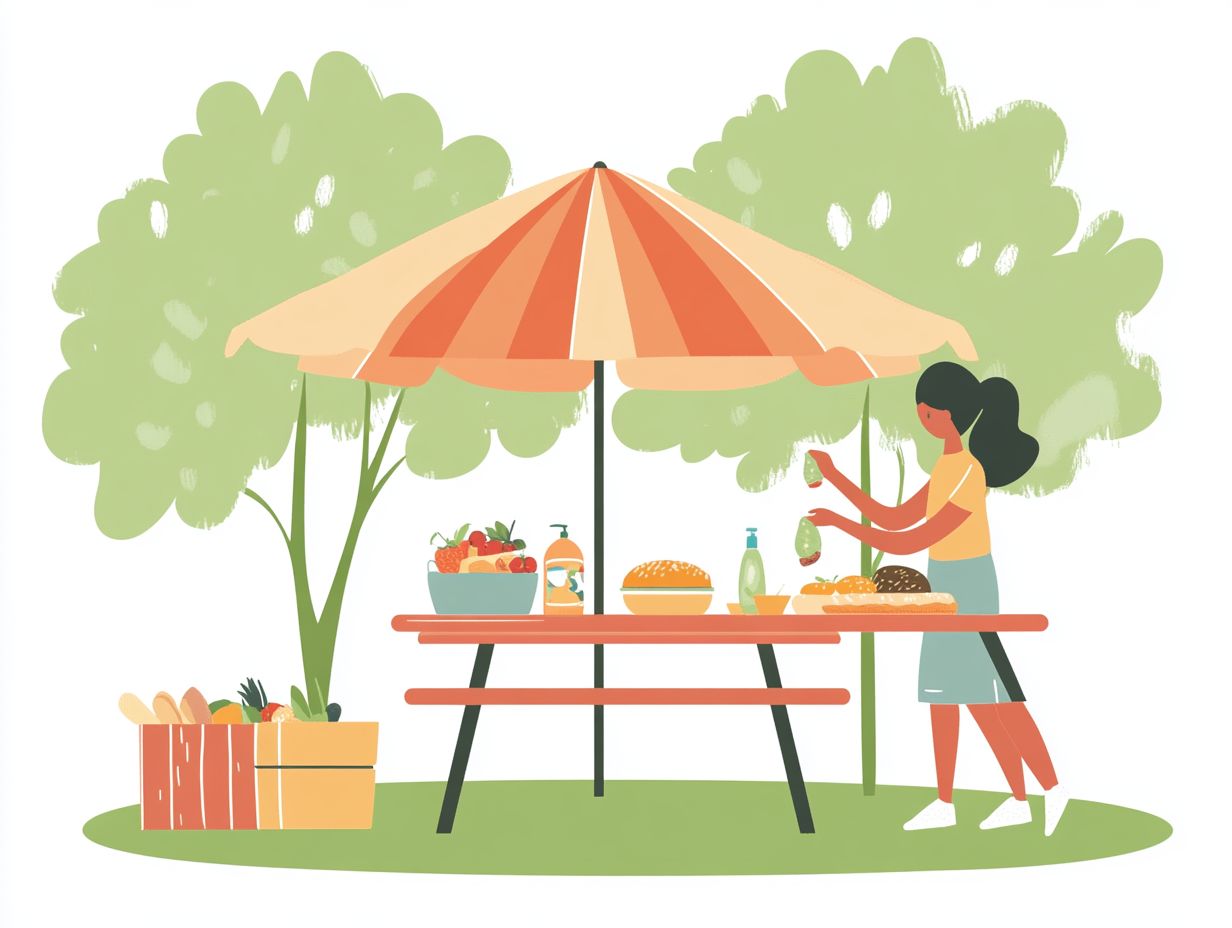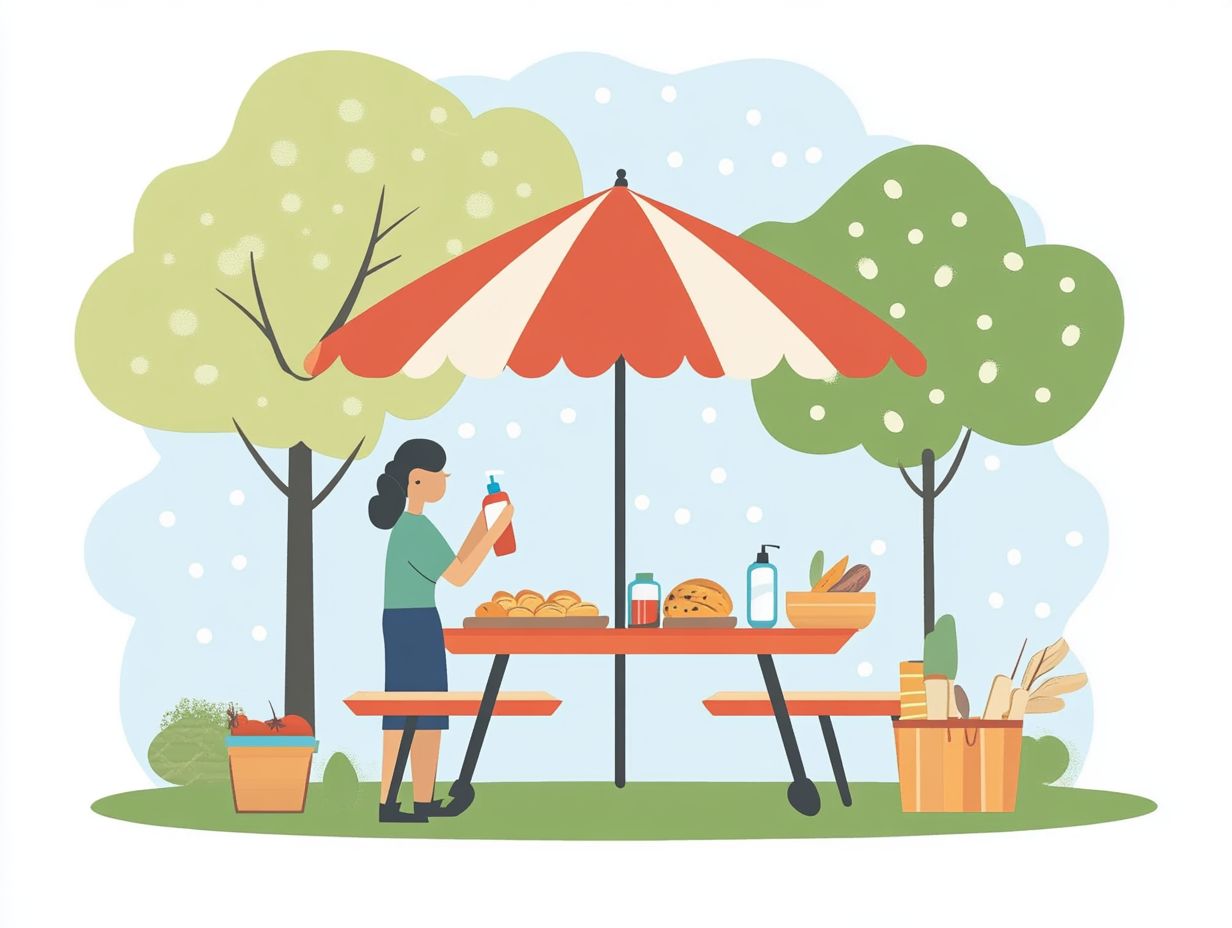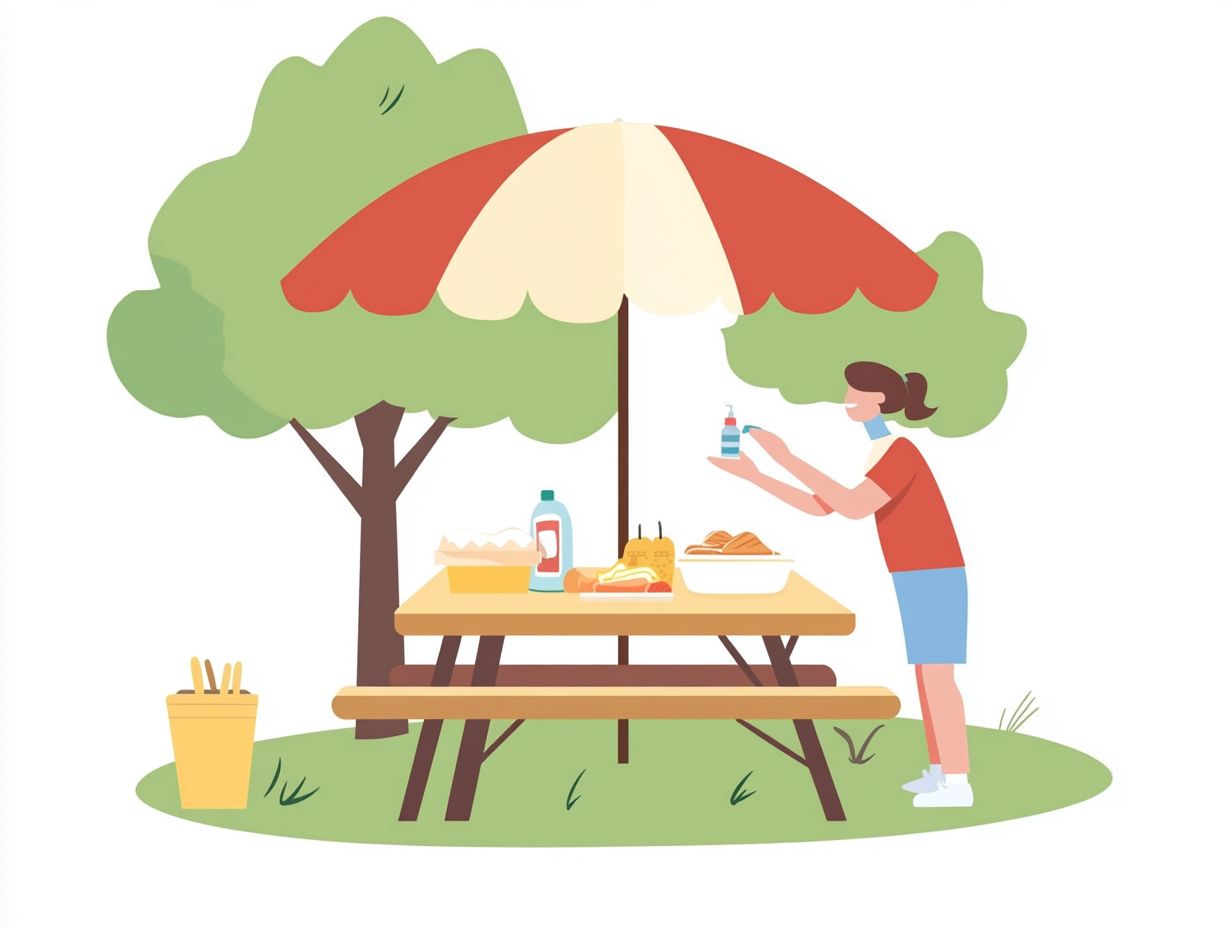How Do I Avoid Food Contamination Outdoors?
Food contamination is a more widespread concern than you might think, particularly when enjoying outdoor meals. Grasping the concept and the potential scenarios that lead to contamination is vital for ensuring that your dining experiences remain both safe and pleasurable, especially when considering picnic safety.
This article delves into the various causes of food contamination in outdoor environments, highlights the signs and symptoms to watch for, and offers practical prevention tips related to food safety. Whether you’re gearing up for a picnic or summer cookouts, you’ll uncover essential practices that will help keep your food safe and your health protected.
Contents
- Key Takeaways:
- Understanding Food Contamination
- Common Causes of Food Contamination Outdoors
- Signs and Symptoms of Food Contamination
- Preventing Food Contamination Outdoors
- What to Do if You Suspect Food Contamination
- Frequently Asked Questions
- How do I avoid food contamination outdoors?
- What is the best way to store food when camping or picnicking?
- How can I keep my food at the correct temperature when outdoors?
- Are there any specific foods that are more prone to contamination outdoors?
- What should I do if I suspect my food has been contaminated?
- What are some ways to practice good hygiene when handling food outdoors?
Key Takeaways:

- Keep food safe by understanding and preventing contamination, which can cause food poisoning and ruin outdoor activities.
- Know the signs and symptoms of food contamination to identify potential risks associated with foodborne illness.
- Practice proper food storage and handling techniques, including using separate coolers for perishable food, and take immediate action if you suspect contamination to protect your health and safety.
Understanding Food Contamination
Understanding food contamination is essential for ensuring your food safety, especially during summer activities like outdoor meals, picnics, and family gatherings.
Food contamination can occur when harmful bacteria, viruses, or parasites make their way into your food due to improper handling, storage, or preparation methods. This can lead to foodborne illnesses, which are serious public health concerns.
By adhering to sound food handling practices, keeping your hands clean, and being mindful of food storage regulations, you can significantly reduce these risks especially during summer cookouts when hot foods are frequently served outdoors.
What is Food Contamination?
Food contamination refers to the presence of harmful substances or microorganisms in your food that can lead to foodborne diseases, commonly known as food poisoning.
This issue can originate from various sources, including germs like bacteria, viruses, and parasites, as well as chemical contaminants such as pesticides and heavy metals. Food contamination comes in several forms: biological, chemical, and physical, each presenting distinct risks to your health.
The consequences of consuming contaminated food can range from mild gastrointestinal discomfort to severe, long-term health complications. Therefore, it is essential for both individuals and businesses to adopt rigorous cleaning and food-handling practices.
By employing proper sanitation methods like thorough handwashing and using clean utensils you can significantly reduce the risks associated with contamination and ultimately ensure the safety and well-being of everyone enjoying the food.
Common Causes of Food Contamination Outdoors
Common causes of food contamination during outdoor meals can greatly affect the safety of the fare served at your picnics and summer cookouts, posing serious health risks like foodborne illnesses.
Factors like cross-contamination, mixing raw and cooked foods, improper food storage, and neglecting to maintain safe temperatures can all lead to the unchecked growth of bacteria and food pathogens in outdoor dining situations. Following safe food handling tips can keep your outdoor meals safe and enjoyable!
To ensure safety, remember to follow the tips shared in this article. Implementing these practices can help you enjoy outdoor meals without worry. Stay safe and have fun!
Possible Sources of Contamination

Possible sources of contamination in your outdoor meals often include raw meat, unpasteurized eggs, and improper food storage methods that overlook safe temperatures. To ensure safety, consider these top food safety tips for outdoor events.
These issues can become even more pronounced during summer activities. The heat and humidity create an ideal environment for harmful bacteria to thrive. For instance, leaving food out in the sun for too long can lead to rapid spoilage, putting everyone at risk of foodborne illnesses.
Use food thermometers to check that meats reach the right internal temperatures. This significantly reduces the chances of contamination.
Employing proper storage techniques like keeping perishable items in insulated coolers is vital for maintaining food safety while you savor outdoor festivities. Be proactive! Enjoy your summer meals worry-free by following these simple safety tips.
Signs and Symptoms of Food Contamination
Recognizing the signs and symptoms of food contamination is crucial for effective illness prevention. This is especially important when managing the risk of foodborne illnesses that can stem from improper food handling during summer activities.
Symptoms often include nausea, vomiting, diarrhea, and cramps. These can appear anywhere from a few hours to several days after consuming contaminated food.
By understanding these symptoms and adhering to health guidelines, you enable yourself to take swift action, ensuring your safety and the well-being of your family during outdoor gatherings.
Identifying Potential Contamination
Identifying potential contamination in food is essential for maintaining food hygiene and ensuring safety, especially during outdoor events where risks can be heightened.
Conducting thorough checks significantly reduces the likelihood of foodborne illnesses. Be alert for any unusual odors that might signal spoilage. Examine for discoloration or unusual textures that deviate from the norm.
By prioritizing these practices, you not only safeguard your own health but also foster a safer environment for everyone attending. Implementing risk management techniques such as maintaining proper storage temperatures and conducting regular inspections allows for a proactive stance in mitigating food safety risks. Your awareness can effectively prevent contamination events before they even arise.
Preventing Food Contamination Outdoors
Preventing food contamination outdoors requires you to embrace strong food safety practices that effectively shield against potential health risks, especially during delightful summer cookouts and picnics. For tips on how to cook meat safely outdoors, make sure to follow the best guidelines.
It s essential to employ proper sanitation methods, such as using clean serving ware, designating separate coolers for perishable items, and ensuring adherence to safe temperature guidelines.
These steps are vital for minimizing risks associated with outdoor dining. When planning and preparing your meals, prioritize safe food options to elevate the overall safety of the offerings you serve to your family and friends.
Best Practices for Food Safety

Implementing best practices for food safety is essential to ensure that your outdoor meals are not only safe but also enjoyable for everyone involved.
To achieve this, planning ahead is key. Curate a menu that features easy-to-handle foods, while considering potential temperature fluctuations and the risk of pests.
Before the event, focus on meticulous meal preparation; wash fruits and vegetables thoroughly, and ensure meats are cooked to the recommended internal temperatures.
Hygiene practices are equally critical set up handwashing stations equipped with soap and clean water, along with sanitizing wipes for surfaces.
Choosing safe food options, like pre-packaged snacks and dishes that can be served cold, will significantly reduce the risk of foodborne illnesses, allowing you to enjoy the feast without worry.
Proper Food Storage and Handling Techniques
Proper food storage and handling techniques are vital for maintaining safe temperatures and preventing foodborne illnesses during your outdoor gatherings.
When you’re planning a picnic or barbecue, keep foods at the right temperatures to prevent bacterial growth. Use insulated coolers for hot dishes and refrigerate perishables. This not only preserves their flavor but also enhances safety.
As you prepare your meals, check the thermometer regularly. Ensure that meats reach safe internal temperatures and cold items stay below 40 F. Using airtight containers also protects your food from contaminants, extending its freshness.
By following these practices, you can ensure a delightful and safe outdoor dining experience for everyone.
What to Do if You Suspect Food Contamination
If you suspect food contamination, act quickly to prevent foodborne illness and protect your health, especially during summer cookouts and outdoor dining experiences. Follow health guidelines regarding food disposal:
- Steer clear of questionable food,
- Dispose of it properly, and
- Monitor your symptoms closely.
If symptoms emerge, consult a healthcare professional to ensure swift treatment and minimize potential health risks.
Steps to Take for Your Health and Safety
Act now to protect your health and safety if you suspect a foodborne illness due to contamination.
Be vigilant about any symptoms you might experience, like nausea, vomiting, or diarrhea. Documenting these occurrences can help your healthcare provider. Keep track of any meals consumed before feeling unwell; this information can help identify the source of the issue.
If symptoms persist or worsen, seek medical attention immediately. Health professionals can provide guidance, recommend tests, and ensure you receive appropriate treatment.
Remember, staying hydrated and getting plenty of rest are essential for recovery from potential foodborne illnesses.
Frequently Asked Questions

How do I avoid food contamination outdoors?
To avoid food contamination outdoors, follow proper food safety measures. This includes storing and handling food correctly, keeping it at safe temperatures, and practicing good hygiene. For more detailed tips, check out how to practice safe eating while camping.
What is the best way to store food when camping or picnicking?
The best way to store food when camping or picnicking is to use airtight containers or coolers with ice packs. This prevents bacteria from growing and keeps your food fresh.
How can I keep my food at the correct temperature when outdoors?
To keep your food at the correct temperature zone, pack enough ice packs or use a cooler with proper insulation. You can also freeze items planned for later to keep them cold and ensure safety, especially for perishable food.
Are there any specific foods that are more prone to contamination outdoors?
Yes, certain foods are more prone to contamination outdoors, such as raw meat, dairy products, and cooked foods left out too long. To ensure safety when cooking outside, it’s important to understand if outdoor cooking is safe and take extra precautions when handling and storing these foods to prevent bacterial growth.
What should I do if I suspect my food has been contaminated?
If you suspect your food has been contaminated, dispose of it immediately. Do not taste or consume it. It s safer to avoid potential foodborne illness.
What are some ways to practice good hygiene when handling food outdoors?
To practice good hygiene when handling food outdoors, wash your hands thoroughly before and after handling food. Use hand sanitizer if water is not available. Additionally, it’s important to know how to handle cooking utensils safely outdoors and clean and disinfect any surfaces or utensils that come into contact with food.





